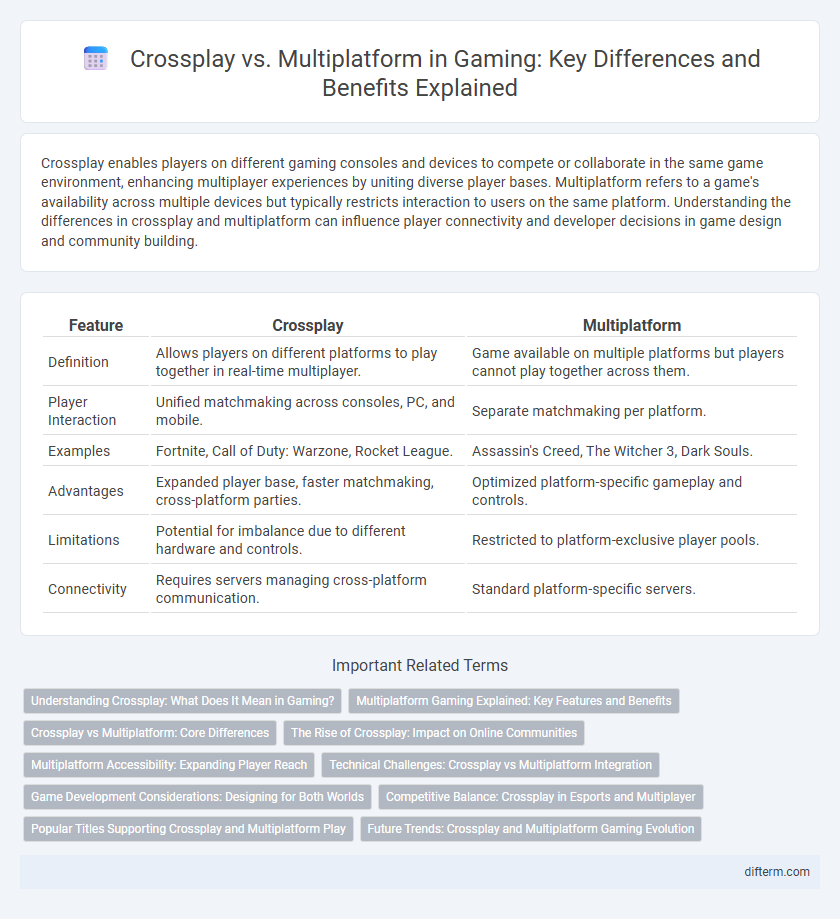Crossplay enables players on different gaming consoles and devices to compete or collaborate in the same game environment, enhancing multiplayer experiences by uniting diverse player bases. Multiplatform refers to a game's availability across multiple devices but typically restricts interaction to users on the same platform. Understanding the differences in crossplay and multiplatform can influence player connectivity and developer decisions in game design and community building.
Table of Comparison
| Feature | Crossplay | Multiplatform |
|---|---|---|
| Definition | Allows players on different platforms to play together in real-time multiplayer. | Game available on multiple platforms but players cannot play together across them. |
| Player Interaction | Unified matchmaking across consoles, PC, and mobile. | Separate matchmaking per platform. |
| Examples | Fortnite, Call of Duty: Warzone, Rocket League. | Assassin's Creed, The Witcher 3, Dark Souls. |
| Advantages | Expanded player base, faster matchmaking, cross-platform parties. | Optimized platform-specific gameplay and controls. |
| Limitations | Potential for imbalance due to different hardware and controls. | Restricted to platform-exclusive player pools. |
| Connectivity | Requires servers managing cross-platform communication. | Standard platform-specific servers. |
Understanding Crossplay: What Does It Mean in Gaming?
Crossplay enables gamers on different platforms such as PC, Xbox, and PlayStation to play together in the same multiplayer environment, breaking traditional barriers set by multiplatform gaming where the same game is available on various devices but players cannot interact across them. This feature enhances community building by uniting player bases and boosting matchmaking efficiency by increasing the available pool of competitors. Developers implement crossplay using compatible network protocols and unified servers, prioritizing seamless gameplay experience while addressing challenges like input method disparities and platform-specific policies.
Multiplatform Gaming Explained: Key Features and Benefits
Multiplatform gaming enables players to access the same game across different devices, such as consoles, PCs, and mobile phones, without restricting gameplay options to a single platform. Key features include synchronized progress, consistent game updates, and unified account management, enhancing user convenience and engagement. Benefits involve expanded player bases, increased game longevity, and flexibility in device usage for immersive gaming experiences.
Crossplay vs Multiplatform: Core Differences
Crossplay enables gamers on different hardware platforms, such as PlayStation, Xbox, and PC, to interact and compete in the same game environment, breaking down ecosystem barriers. Multiplatform refers to a game being available on multiple platforms independently, without necessarily supporting simultaneous player interaction across these devices. Understanding these distinctions is crucial for developers aiming to expand player bases and enhance multiplayer experiences.
The Rise of Crossplay: Impact on Online Communities
Crossplay enables gamers on different hardware platforms to interact seamlessly, breaking down barriers between console, PC, and mobile players while fostering larger, more diverse online communities. This increased connectivity enhances matchmaking speed, player retention, and social interaction, creating a more unified gaming ecosystem. Multiplatform releases, while offering accessibility, lack the real-time interoperability of crossplay, making crossplay a pivotal factor in shaping modern multiplayer experiences.
Multiplatform Accessibility: Expanding Player Reach
Multiplatform accessibility significantly expands player reach by allowing gamers to access titles on various devices, including consoles, PCs, and mobile platforms, without restrictions. Unlike crossplay, which primarily enables interaction across different platforms, multiplatform ensures the game is available natively on multiple systems, increasing potential user base and sales. This approach optimizes exposure and inclusivity, catering to diverse gaming preferences and hardware capabilities.
Technical Challenges: Crossplay vs Multiplatform Integration
Crossplay requires real-time data synchronization across diverse hardware architectures and network protocols, posing significant challenges in maintaining low latency and consistent gameplay experience. Multiplatform integration focuses more on adapting the game's codebase to run seamlessly on different operating systems and hardware capabilities without necessarily enabling simultaneous player interaction. Ensuring compatibility between various input devices, server infrastructures, and matchmaking algorithms is critical for successful crossplay functionality compared to the relatively isolated environment of multiplatform releases.
Game Development Considerations: Designing for Both Worlds
Designing games for both crossplay and multiplatform environments requires optimizing network code and user interfaces to ensure seamless player interaction across diverse devices and systems. Developers must balance performance constraints, account for input method differences, and implement robust matchmaking algorithms to maintain fair gameplay. Prioritizing scalable architecture and consistent content delivery enhances player engagement and broadens market reach.
Competitive Balance: Crossplay in Esports and Multiplayer
Crossplay in esports enables players from different platforms to compete together, fostering a larger, more diverse talent pool and enhancing competitive balance. However, variations in input devices, such as controllers versus mouse and keyboard, can create skill disparities that affect fairness. Maintaining equilibrium requires developers to implement input-based matchmaking and standardized game settings to ensure a level playing field across platforms.
Popular Titles Supporting Crossplay and Multiplatform Play
Popular gaming titles such as Fortnite, Call of Duty: Warzone, and Rocket League support both crossplay and multiplatform functionality, allowing gamers to connect across devices like PC, Xbox, PlayStation, and Nintendo Switch. Crossplay enables players using different hardware to compete or cooperate in the same game environment, while multiplatform play refers to a game's availability across multiple devices without necessarily enabling inter-platform interaction. This dual support maximizes player engagement and community growth by breaking down barriers between console and PC gamers.
Future Trends: Crossplay and Multiplatform Gaming Evolution
Crossplay and multiplatform gaming are rapidly converging as the industry prioritizes seamless player connectivity and broader audience engagement. Advances in cloud gaming, network infrastructure, and universal matchmaking systems are enabling gamers on PC, consoles, and mobile devices to interact without platform barriers. Future trends indicate increased developer investment in unified ecosystems, fostering competitive fairness, expanded social features, and enhanced gameplay experiences across diverse hardware environments.
crossplay vs multiplatform Infographic

 difterm.com
difterm.com